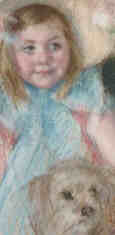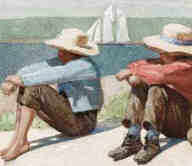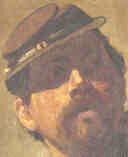Monet
was born in Paris, but he spent most of his childhood in Le Havre. There,
in his teens, he studied drawing; he also painted seascapes outside with
the French painter Eugene Louis Boudin. By 1859 Monet had committed himself
to a career as an artist and began to spend as much time in Paris as possible.
During the 1860s he was associated with the preimpressionist painter Edouard
Manet, and with other aspiring French painters destined to form the impressionist
school — Camille Pissarro, Pierre Auguste Renoir, and Alfred Sisley.
Working outside, Monet painted simple landscapes
and scenes of contemporary middle-class society, and he began to have some
success at official exhibitions. As his style developed, however, Monet
violated one traditional artistic convention after another in the interest
of direct artistic expression. His experiments in rendering outdoor sunlight
with a direct, sketchlike application of bright color became more and more
daring, and he seemed to cut himself off from the possibility of a successful
career as a conventional painter supported by the art establishment.
In 1874 Monet and his colleagues decided
to appeal directly to the public by organizing their own exhibition. They
called themselves independents, but the press soon derisively labeled them
impressionists because their work seemed sketchy and unfinished (like a
first impression) and because one of Monet's paintings had borne the title
Impression:
Sunrise (1872). Monet's compositions from this time are extremely
loosely structured, and the color was applied in strong, distinct strokes
as if no reworking of the pigment had been attempted. This technique was
calculated to suggest that the artist had indeed captured a spontaneous
impression of nature. During the 1870s and 1880s Monet gradually refined
this technique, and he made many trips to scenic areas of France, especially
the Mediterranean and Atlantic coasts, to study the most brilliant effects
of light and color possible.
By the mid-1880s Monet, generally regarded
as the leader of the impressionist school, had achieved significant recognition
and financial security. Despite the boldness of his color and the extreme
simplicity of his compositions, he was recognized as a master of meticulous
observation, an artist who sacrificed neither the true complexities of nature
nor the intensity of his own feelings. In 1890 he was able to purchase some
property in the village of Giverny, not far from Paris, and there he began
to construct a water garden (now open to the public)—a lily pond arched
with a Japanese bridge and overhung with willows and clumps of bamboo.
Beginning in 1906, paintings of the pond
and the water lilies occupied him for the remainder of his life; they hang
in the Orangerie, Paris; the Art Institute of Chicago; and the Museum of
Modern Art in New York City. Throughout these years he also worked on his
other celebrated “series” paintings, groups of works representing the same
subject—haystacks, poplars, Rouen Cathedral, the river Seine—seen in varying
light, at different times of the day or seasons of the year. Despite failing
eyesight, Monet continued to paint almost up to the time of his death at
Giverny.
— Painter, artist, initiator, leader, and unswerving advocate of the
Impressionist style. In mature works, developed method of producing several
studies of the same subject in series, changing canvases with the light
or as his interest shifted. These "series" were generally dated and were
often exhibited in groups. Moved with his family to Le Havre in 1845. He
attended public school in Le Havre and learned to draw from François-Charles
Ochard, although the early instruction he received from Eugène Boudin
was more critical. In 1859 Monet traveled to Paris where he attended the
Académie Suisse and began a friendship with the older Camille Pissarro.
He received formal art training in 1863 in the studio of Charles Gleyre,
where he met Bazille, Renoir, and Sisley. Despite the acceptance of paintings
at the Salons of 1865 and 1866, he suffered severe financial problems.
In 1873 Monet and other artists in his circle
formed the Société Anonyme Coopérative d'Artistes-Peintres-Sculpteurs-Graveurs,
which in 1874 held its first group show, later known as the first impressionist
exhibition. Monet exhibited Impression:
Sunrise, the painting from which the impressionists derived their
name. Monet also participated in the second (1876), third (1877), fourth
(1879), and seventh (1882) impressionist exhibitions. During his career,
Monet painted in a number of locations throughout France as well as in London,
Venice, the Low Countries, and Scandinavia. He established studios at Argenteuil
(1871), then Vetheuil (1878), and finally Giverny (1883), where he bought
a house and property in 1890 and began to concentrate on the famous paintings
of his gardens. As Monet grew older, his eyesight deteriorated, but despite
his failing vision, he continued to paint until his death. His last years
were preoccupied by his grand cycles of water lily paintings.
— LINKS
— Le
Pont Japonais (1925, 88x115cm; recommended 915x1200pix; 1013kb_ ZOOM
to 1525x2000pix; 3246kb) _ Monet made the footbridge in his garden at Giverny
the subject of two series in 1895-1900 and 1919, and he returned to its
wisteria-covered frame repeatedly in the 1920s. With its raw vigor and passionate
coloring, this picture underscores an observation Monet once made of his
water landscapes in general - it reveals "the instability of a universe
transforming itself every moment before our eyes."
— Grainstack,
Sun in the Mist (1891, 60x100cm; recommended 718x1200pix; 773kb_ ZOOM
to 1196x2000pix; 2281kb) _ In the late 1880s, Claude Monet analyzed visual
perception by representing the same subject under varying conditions of
light, atmosphere, and weather. In one such series, he depicted the grainstacks
near his house in Giverny. These conical structures of wheat, 5 to 7 meters
high, protected the grain from rain and rodents. Typical of farming practice
in France, the stacks came to symbolize the country's rural prosperity.
Monet studied the grainstacks during different seasons as the sunlight changed
in intensity. This picture shows the autumn dawn, at a moment when the sun
evaporates the night's mist. The grainstack is seen against the morning
light, which forms a halo around it. Up close, one sees a flickering patchwork
of broken brushstrokes, each one a notation of light. At a distance, these
colors coalesce into a brilliant, shimmering image.
— Haystacks,
Snow Effect (1891, 65x92cm; 446x635pix, 131kb) _ Monet’s paintings of
haystacks were among the boldest of his career. In the early 1890s he made
a series of 25 pictures, each showing massive stacks of grain under a variety
of light and weather conditions. Here they are seen against snow and sunshine,
their bulky forms casting bright blue shadows. The intense colors and almost
abstract pattern that they make fascinated Monet. But the picture’s real
subject is the atmosphere itself – a freezing mist that positively glows
with light.
— Thames
below Westminster (1871, 47x72cm; 415x635pix, 91kb) _ Monet thought
that London’s smog, made the city a very exciting subject for painting.
In this view of the Thames, this mixture of fog and smoke is tinged with
weak spring sunshine. Monet renders nearly the entire scene in pale, closely
matched colours, observing how the plumes of smoke rising from the steamboats
add to the foggy atmosphere. Only the wooden pier on the right stands out.
Its striking geometry contrasts to the misty, ghostlike towers of the Houses
of Parliament behind.
— Water
Lilies (1916, 166x142cm; recommended 1/6 size; 261kb _ ZOOM
to 1/3 size; 985kb _ ZOOM++
to 2/3 size; 3857kb)
— Waves
Breaking (1881, 60x81cm; recommended 1/3 size; 263kb _ ZOOM
to 2/3 size; 975kb)
— Sailboats
on the Seine (1874, 54x65cm; recommended 2/5 size; 318kb _ ZOOM
to 4/5 size; 1328kb)
— The
Grand Canal, Venice (1908, 73x90cm; recommended 3/10 size; 173kb
_ ZOOM
to 3/5 size)
— Still
Life with Pheasants and Plovers (1879, 68x90cm; recommended 904x1200pix
_ ZOOM
to 1507x2000pix)
— Garden
in Bordighera, Impression of Morning
— Impression:
Sunset, Pourville (1882) — Impression:
Sunrise (1872)
— La
Seine à Bougival le Soir (1869, 60x74cm)
— The
Headland of the Hève at Low Tide (1865, 90x150cm)
— La
Plage à Honfleur (1865, 60x81cm) — Camille
Monet en Japonaise (1876)
— La
Rue Montargueil Pavoisée (1878) — Nénuphars I
(1905) — Boulevard
des Capucines (1873)
— Le
Déjeuner sur l'Herbe (1865; 755x1074pix) _ central
detail (1113x978pix) _ detail
at left (800x584pix, 144kb) _ study for this detail: The
Strollers (1059x778pix) _ not to be confused with the less dressy Le
Déjeuner sur l'Herbe (1863, 214x269cm) by Manet.
— 1034
images at Webshots — 189
images at ABC. |

 ^
05 December 2002: Major auction
of US art at Christie's
in New York.
^
05 December 2002: Major auction
of US art at Christie's
in New York. —
Study
for ‘The Wounded Drummer Boy’ [< thumbnail]
by Eastman
Johnson [1824-1906] —
—
Study
for ‘The Wounded Drummer Boy’ [< thumbnail]
by Eastman
Johnson [1824-1906] —  —
Girl
in the Hammock by Winslow
Homer [1836-1910] — A
Shady Spot, Houghton Farm by Homer
—
Girl
in the Hammock by Winslow
Homer [1836-1910] — A
Shady Spot, Houghton Farm by Homer